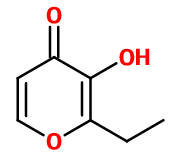
Photo credits: ScenTree SAS
Ethyl maltol
2-ethyl-3-hydroxypyran-4-one ; EM-1 crystal grain ; EM-400 crystal grain ; 2-ethyl pyromeconic acid ; 2-ethyl-3-hydroxy-4-pyrone ; Ethylmaltol ; 3-hydroxy-2-ethyl-1,4-pyrone ; 3-hydroxy-2-ethyl-4-pyrone ; 3-hydroxy-2-ethyl-gamma-pyrone

Photo credits: ScenTree SAS
| Company | Ingredient Name | ID | Naturality | Purity | Latin name | Treated part | Geographical origin | Certifications | Comments | MOQ |
|---|---|---|---|---|---|---|---|---|---|---|
|
|
Ethyl Maltol - 30 Gr | - | - | - | - | - | - | more | - |
General Presentation
-
CAS N° : 4940-11-8
-
EINECS number : 225-582-5
-
FEMA number : 3487
-
Density : Donnée indisponible.
-
Optical rotation : Donnée indisponible
-
Allergens : This ingredient does not contain any allergen.
-
Refractive Index @20°C : Donnée indisponible
-
Volatility : Base
-
Price Range : €€
-
Appearance : White solid
-
FLAVIS number : 07.047
-
JECFA number : 1481
Information on synthetic ingredients
-
Acid Value : Donnée indisponible
-
Boiling Point :
-
Detection Threshold : Donnée indisponible.
-
Molecular formula : C7H8O3
-
Log P : 0,61
-
Molecular Weight : 140,14 g/mol
-
Fusion Point : 90°C
-
Flash Point : >100°C (>212°F)
-
Vapor pressure : Donnée indisponible
Uses
Other comments :
Ethyl maltol is a classical compound in perfumery, often combined with Maltol and widely used today in order to bring an addictive and greedy note. More powerful than Maltol.
Stability :
Unstable in shower gel and shampoo bases.
Uses in perfumery :
Ethyl maltol is used in gourmand, sweet and cooked fruit notes, to add a caramel, burnt and vanillic facet.
Year of discovery :
1963
Isomerism :
Ethyl maltol does not have any isomer used in perfumery.
Synthesis precursor :
Ethyl maltol is not a precursor to the synthesis of another compound of olfactory interest.
Natural availability :
Ethyl maltol is not available in its natural state.
Synthesis route :
The synthesis of Ethyl maltol can be done in a single reactor starting from alpha-ethylfurfuryl alcohol. A treatment of this molecule with chlorine allows to enlarge the cycle and to give a intermediate halogenated pyrane. This molecule can then be subjected to a strong acid hydrolysis, which leads to the synthesis of Ethyl maltol.
Regulations & IFRA
This ingredient is not restricted

